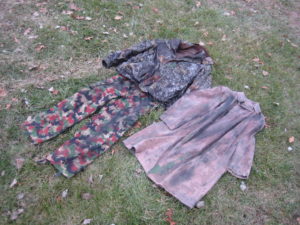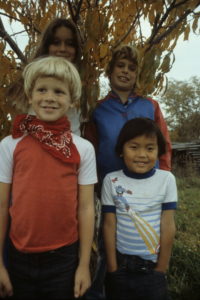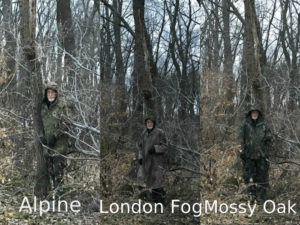A Few Notes About Camouflage
Many people, who are interested in watching/documenting/hunting wild animals, improve their odds of success by wearing camouflage. Camo can also be turned into interesting children’s games and challenges, especially if they make their own camo.

The pants here have an alpine pattern.
Pattern over color – For many creatures, shapes and patterns are at least as important as colors for them to discern whether you are an object of concern. One type of older pattern still in use is the “alpine” pattern, in which the individual color blebs resemble interlocked Rorschach inkblots. This is a generic style, not intended to look exactly like any particular landscape, but to remain vague and inconspicuous in a variety of circumstances.
More modern camos often begin as actual photos, whose patterns and colors get merged onto cloth. Amongst hunters around here, the “mossy oak” style is today most common, duplicating our oak-hickory woodlands in mid-late autumn. This is illustrated by the bulky jacket in the preceding photo, above the alpine pants. Other patterns and colors are available, which match brown cattails, green sagebush, brown dry sand, etc.
Making Your Own Camo – For many years, my only deer-hunting camo was an oversize London Fog trenchcoat, which I bought for $2 because it had a large coffee stain. So I upgraded the stain by burying it for a month in a pile of damp oak leaves, which were composting in my yard, and imparted some blotchy tannin stains to the coat. A year later, some narrow streaks of paint left over from a household project were added. This is the long coat in the preceding photo.

The Drake children and “Dad’s” peach tree, autumn 1978.
Children’s Games – Children can create their own camo outfits from scraps of cloth (including burlap), old clothing, dye, paint, hot glue, etc. One simple game is some version of hide and seek in the woods. On larger semi-wild properties, like those of Bur Oak Land Trust, a more sophisticated game is that the camoed hiders move stealthily toward a goal without getting caught.
My most memorable camo hide and seek game was with my children 40 years ago. We had a little peach tree in our yard, about eight feet high, and in early autumn it would turn a bronzy yellow-orange. I had found some gaudy, silky Hawaiian flower pattern cloth, and toned it down with a light touch of brown kit dye. When it was my turn to hide from the children in the early twilight, I shinnied up into the little peach tree and broke up my outline with the cloth. They could not find me, even though they passed close by, in part because that location was so unexpected. They finally gathered for a conference almost below me, and I yelled and leaped out to scare them. Unfortunately, I landed badly and tore the lower joint in my thumb. Fortunately, a neighbor was a surgeon and invited me over that evening and did corrective surgery at his kitchen table. I still have the scar, and we all have the memories.

Three camo styles taken nearly simultaneously in early twilight.
The effect of camo colors and patterns depends partially upon lighting. Under bright clear skies, the three shown on the first photo look quite different. But as tree or cloud shadows increase, or sunlight diminishes, they all begin to appear increasingly alike.


